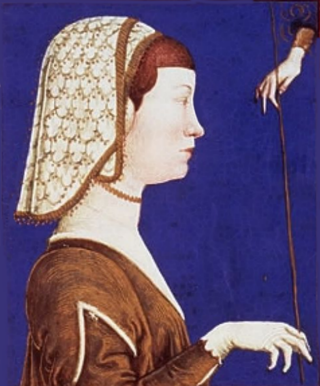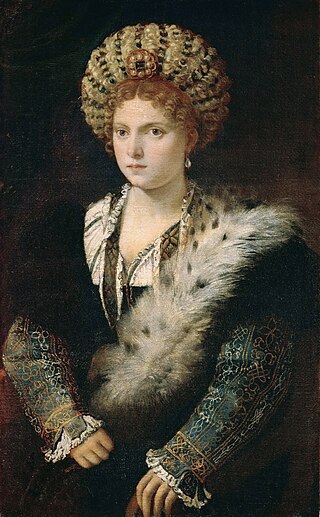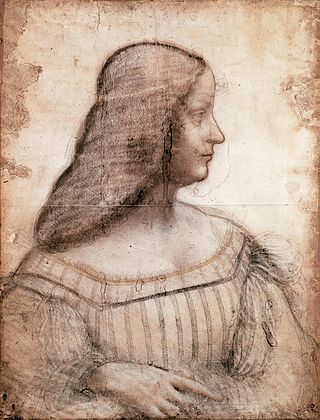
Isabella d'Este was Marchioness of Mantua and one of the leading women of the Italian Renaissance as a major cultural and political figure.

Ludovico Maria Sforza, also known as Ludovico il Moro, and called the "arbiter of Italy" by historian Francesco Guicciardini, was an Italian nobleman who ruled as the Duke of Milan from 1494 to 1499.

Cecilia Gallerani was the favourite and most celebrated of the many mistresses of Ludovico Sforza, known as Lodovico il Moro, Duke of Milan. She is best known as the subject of Leonardo da Vinci's painting The Lady with an Ermine. While posing for the painting, she invited Leonardo, who at the time was working as court artist for Sforza, to meetings at which Milanese intellectuals discussed philosophy and other subjects. Cecilia herself presided over these discussions.
Elaine Lobl Konigsburg was an American writer and illustrator of children's books and young adult fiction. She is one of six writers to win two Newbery Medals, the venerable American Library Association award for the year's "most distinguished contribution to American children's literature."

La Belle Ferronnière is a portrait of a lady, usually attributed to Leonardo da Vinci, in the Louvre. It is also known as Portrait of an Unknown Woman. The painting's title, applied as early as the seventeenth century, identifying the sitter as the wife or daughter of an ironmonger, was said to be discreetly alluding to a reputed mistress of Francis I of France, married to a certain Le Ferron. Later she was identified as Lucretia Crivelli, a married lady-in-waiting to Duchess Beatrice of Milan, who became another of the Duke's mistresses.

Isabella of Aragon, also known as Isabella of Naples, was by marriage Duchess of Milan and suo jure Duchess of Bari.

Beatrice d'Este was Duchess of Bari and Milan by marriage to Ludovico Sforza. She was one of the most important personalities of the time and, despite her short life, she was a major player in Italian politics. A woman of culture, an important patron, a leader in fashion: alongside her illustrious husband she made Milan one of the greatest capitals of the European Renaissance. With her own determination and bellicose nature, she was the soul of the Milanese resistance against the enemy French during the first of the Italian Wars, when her intervention was able to repel the threats of the Duke of Orléans, who was on the verge of conquering Milan.

Lucrezia Crivelli was a mistress of Ludovico Sforza "il Moro", Duke of Milan. She was the mother of Sforza's son, Giovanni Paolo I Sforza, Marquess of Caravaggio. Crivelli has been thought to be the subject of Leonardo da Vinci's painting, La belle ferronnière.

Eleanor of Naples was Duchess of Ferrara by marriage to Ercole I d'Este. She was the first duchess of Ferrara, and mother of many famous Renaissance figures. She was a well known political figure, and served as regent of Ferrara during the absence of her spouse.

The 16th-century portrait Mona Lisa, or La Gioconda, painted in oil on a poplar panel by Leonardo da Vinci, has been the subject of a considerable deal of speculation.

Isabella in Black is a portrait of a young woman by Titian. It can be dated to the 1530s and is in the Kunsthistorisches Museum in Vienna. The artist and the date are undisputed. Beyond the museum documentation, there are repeated doubts about the person depicted.

The Portrait of Isabella d'Este is a drawing by Leonardo da Vinci which was executed between 1499 and 1500. It depicts Isabella d'Este, Marchioness of Mantua. During the Italian Wars of 1499–1504, the French invaded Italy which caused Leonardo to flee from Milan toward Mantua. There he had met Isabella, where she commissioned her portrait from him. Whether Leonardo completed the portrait is unknown. There is evidence through letters of the time that he held a fully completed painting of her but they are vague in describing it. It is possible that the painting was lost to time or that it was in fact never completed at all. A version of the portrait in oils on canvas was found in a collection in Switzerland in 2015 but it has yet to be verified.

Gian Giacomo Caprotti da Oreno, better known as Salaì was an Italian artist and pupil of Leonardo da Vinci from 1490 to 1518. Salaì entered Leonardo's household at the age of ten. He created paintings under the name of Andrea Salaì. He was described as one of Leonardo's students and lifelong companion and servant and was the model for Leonardo's St. John the Baptist,Bacchus and Angelo incarnato.

Bernardino de 'Conti was an Italian Renaissance painter, born in 1465 in Castelseprio and died around 1525.

La Scapigliata is an unfinished painting generally attributed to the Italian High Renaissance artist Leonardo da Vinci, and dated c. 1506–1508. Painted in oil, umber, and white lead pigments on a small poplar wood panel, its attribution remains controversial, with several experts attributing the work to a pupil of Leonardo. The painting has been admired for its captivating beauty, mysterious demeanor, and mastery of sfumato.

Atalante Migliorotti was an Italian Renaissance musician, instrument maker and assistant to Leonardo da Vinci.

The Leonardeschi were the large group of artists who worked in the studio of, or under the influence of, Leonardo da Vinci. They were artists of Italian Renaissance painting, although his influence extended to many countries within Europe.

Galeazzo da Sanseverino, known as the son of Fortuna, was an Italian-French condottiere and Grand Écuyer de France; Marquis of Bobbio, Count of Caiazzo, Castel San Giovanni, Val Tidone and Voghera. He was first the favorite of Ludovico il Moro and Beatrice d'Este, then of Louis XII and Francis I of France, as well as a sworn enemy of Gian Giacomo Trivulzio.
On the other hand the Duke of Milan
called and gave the general cane
to Maria Galeazo, and captain
did it of his people on the saddle,
who riding then from hand to hand,
with the banner in the wind of the snake,
honor and glory of Lombardy,
with many great gentlemen in company.

The two–Mona Lisa theory is a longstanding theory proposed by various historians, art experts, and others that Leonardo da Vinci painted two versions of the Mona Lisa. Several of these experts have further concluded that examination of historical documents indicates that one version was painted several years before the second.

Leonardo is a historical drama created by Frank Spotnitz and Steve Thompson. The series was produced by Italian Lux Vide in collaboration with Rai Fiction, Sony Pictures Entertainment, with Frank Spotnitz's Big Light Productions and Freddie Highmore's Alfresco Pictures in association with France Télévisions and RTVE.



















